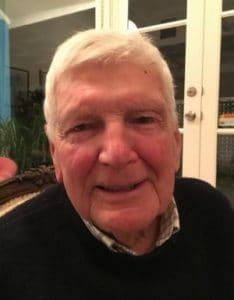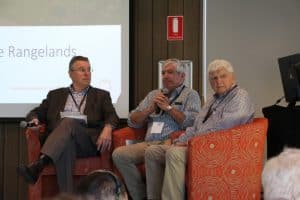
The Australian rangelands community is the poorer for the passing of Andrew David Nicolson on Saturday 2nd June, 2018 aged 86 years – but much the richer for the legacy Andrew created.
Andrew was born third generation into a pastoral family on Middleback Station properties near Whyalla. The family’s story is told in Andrew’s recent book “Wizzo – the Story of a Well and the Nicolson Family”, published last year (see the review of this book in RMN 17/2).
Many people benefited from Andrew’s quiet, deep wisdom and generosity – visitors to Middleback Station (including many generations of rangeland students from the University of Adelaide, and those on field tours from various conferences), participants in meetings of the then South Australian branch of the Australian Rangelands Society, and more recently, visitors to Adelaide Botanic Gardens where Andrew reinvented himself as a garden guide and impressed visitors with first-hand accounts of Australia’s arid vegetation, particularly in the mallee section which has examples of many species on Middleback.
Some of us, myself included, benefited from Andrew’s generosity in assisting us with our research and teaching – allowing us to use the shearers quarters and station facilities, fetching sheep for grazing experiments, unblocking blocked septic systems overloaded by students on camp, and most valuably, sharing his wisdom as a scientific collaborator to benefit our work. Perhaps his most generous act was his agreement to the building of a large field centre with research and teaching facilities within shouting distance of Middleback homestead. Along with the Shearers Quarters, this served as the base for up to four student camps per year, and, on occasion, host to research workers from as far afield as Lund University in Sweden and St Johns in Newfoundland. When the association with the University of Adelaide was formalised in a Joint Venture between the Nicolsons, the University, and the SA Minister for the Environment, Andrew chaired the Board throughout the life of the Agreement.
Andrew was a well-educated man. He was an agricultural science graduate from the University of Adelaide who, upon graduation, worked as a sheep researcher for the CSIRO at Cunnamulla before returning to Middleback. A lifelong learner and assimilator of diverse knowledge, Andrew integrated knowledge of geology, botany, animal production, sheep genetics (one of his father’s interests), economics and people, and applied it to his work on Middleback. Andrews’s son ‘young Andrew’ – now known to many of us a ‘Nico’ – recalls how Andrew’s grandkids received dissertations on the biological significance of the shapes of leaves and other such topics as they drove with him around the property! And… Andrew also knew all the kings and queens of Britain since 1066 and the stories of their ascent and demise!
At last year’s Australian Rangelands Conference I interviewed Andrew and Nico on the occasion of the publication of Andrew’s book. I think this session was one of the highlights of the conference. Andrew would happily have talked for much longer than the 30 minutes we had allowed!

Martin Andrew (left) interviews Andrew (right) and Nico (centre) at the ARS Conference in Pt Augusta in September 2017.
Here are some of the highlights:
- The secret to the Middleback properties success was its subdivision into small paddocks, each grazed by a small number of sheep around a single watering point. This was the model advocated by Peter Waite in the late 19thCentury (after whom the Waite Agricultural Research Institute is named). This was enabled by galvanized iron pipe (later by poly pipe) and wire fencing. The impetus for this development was domestic – the dust was so heavy around Wizzo Well (which watered 12,000 sheep) that the ceiling of the nearby Roopena Homestead collapsed under its weight and Andrew’s grandmother demanded action! George, Andrew’s grandfather, was a blacksmith and an entrepreneur and more interested in engineering than in sheep. He imported steel pipe to supply water from Wizzo Well to tanks and troughs 2 miles apart to get the sheep away from the Well and better distributed across the property.
- When at CSIRO, Andrew learned the importance of keeping accurate records. Every record should be dated, signed and include all other relevant attributes. Andrew discovered old Middleback stock diaries full of entries that were useless because they were undated, unattributed and did not include the paddock details etc.
- Back in the 1950s was a great time to be in the wool industry, especially for a bachelor in outback Queensland! Wool prices were astronomically high. Graziers lived a luxury life. They would import caterers and orchestras from Sydney for local Balls!
- The University of Adelaide’s involvement in Middleback began through networks. The then Professor of Botany, Peter Martin, knew Andrew from University days, and he referred Bob Lange to him. Bob had two students looking for a place to do field work. The rest is history. Sue Barker was the first of a line of researchers who studied ‘piospheres’ (the zone of grazing impact around an arid watering point), one of Bob’s legacies to science. Bob then started bringing up undergraduate students to teach them in a rangelands setting. Initially they camped at an outstation, but soon moved to the Shearer’s Quarters which was much more convenient and logistically easier.
- Andrew and his wife Lesley enjoyed the company of the research students, their foibles and the fresh ideas they stimulated. One was particularly noteworthy – Mark Stafford Smith, who arrived fresh from Cambridge University fair-haired, pale-skinned and wearing sandals (Mark was a second generation Middleback research student, as his supervisor, Dr Ian Noble, had done his PhD field work at Middleback also!) Mark’s rangelands legacy continues as a keynote speaker at this Rangelands conference.
- The symbiotic relationship between Middleback Station and BHP. Each supported the other. Middleback supplied water for the BHP ore train steam engines. The empty wagons transported pipe to Middleback. Middleback loaned spare pipe to BHP when they were short. Middleback mutton was transported in the guards van to butchers’ shops in Whyalla. When the Whyalla Steel Works were in a downtime, BHP occupied its staff by making them available for projects at Middleback, like constructing sheds. Some of these staff went onto to become senior managers in BHP and then OneSteel, and remained loyal supporters of Middleback to the end. Sir Essington Lewis (BHP’s Chairman) always visited Middleback every time he visited Whyalla. He was always constructively critical, pointing out improvements that should be made to the infrastructure, often for safety reasons – and would expect them fixed by his next visit! He had a farm on the Mornington Peninsula and always bought his sheep from Middleback as they were half as big again as the sheep of his Mornington Peninsula neighbours and provided good bragging rights!
- The interview ended on a more sober note. The Middleback properties were acquired by the Defence Department several years ago to expand the Cultana Defence Training Facility. This ended the Nicolson’s tenure just short of a century (see details of the ‘End of an era’ celebration held at Middleback in July 2013 in RMN 13/2). The Middleback properties were among the best managed of the South Australian pastoral properties. However the valuation process by the Defence Department showed there was no premium for having maintained the properties in excellent condition (This matter is still being resolved). This is a sobering message for rangeland professionals.
Andrew had some interesting views on the long, drawn out negotiations around the resumption of the lease, but it didn’t dampen his enthusiasm for his botanical and other interests. Along with friends from his University days, he joined the volunteer guides at Adelaide Botanic Gardens soon after his ‘retirement’ to Adelaide where he enjoyed meeting people from all over the world and, perhaps, explaining the biological significance of the shapes of leaves and other such topics as the visitors (no doubt a poor substitute for grandkids) walked with him around the Gardens.
Nor did it dampen his generosity. He was active in volunteer activities not much more than a month before he died. And in his last few days he donated all his botanical notes, accumulated over 17 years, to the most recent intake of Guides, as well as providing historical information to the new owners of Nonowie, the perpetual lease to the south of Middleback. The Western Myall country he grew up in was never far from his thoughts.
A quiet, unassuming, very thoughtful man whom we shall all miss.
Thanks to Nico, Des Coleman, Carolyn Ireland and Noelene Duckett for their reviews and additions to this article.
Martin Andrew
